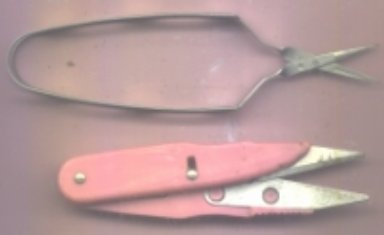Common almost everywhere, fulcrum type shearing tools are commonly called scissors, shears, snips, trimmers or clippers dependent on size and use. Cutting edges are 90 ° or slightly less. To cut thinner material, all use a shearing action that starts near the fulcrum and progresses toward the tips as the handles are squeezed . This action creates a force which often pushes harder and thicker materials toward the tips, requiring a sizable opposite force to accomplish cutting. Some have serrations on the outside of the edges to reduces slipping, which only works with softer material. Blades may be curved laterally as in cuticle scissors. The most important factor is that blade edges are held in close contact through their entire length of cut or else tearing may occur or thin material may slip between them rather than being cut. Dividing lines between names are nebulous and often overlapping. Some trimmers and clippers have multiple blades as with hedge and barber's.
Since most are basically levers with the fulcrum in the middle, the ratio of the relative distances of the squeezing point and the cutting point from the fulcrum determines both the force and movement ratio. When the squeezing point is at a greater distance from the fulcrum than the cutting point, the cutting force is greater and the movement is less than that applied to the handles. This has two effects in selection . Relatively long handles provide greater control through less cutting movement and greater cutting force. The latter is often referred to as the mechanical advantage. As the cutting point moves toward the tip, the movement increases and the force decreases. Due to leverage ratio changes, the squeezing force required increases as cutting point approaches tips.
As mentioned above, there is a force that pushes the work piece toward the tips, which is generated by the angle of attack at the cutting point. Close to the fulcrum the force is greater due to the wide angle. As the point moves toward the tips, both the angle and the force decrease.
Scissors may have very thin or thick blades with sharp pointed or blunt tips in any combination. Although most are designed for specific uses, preferences are determined by the end user. The only general guide lines are that thinner and narrower blades are less rigid than thicker and wider, plus they must fit between two or three dimensional obstacles without obscuring sight of cut. Excess length may limit maneuverability. Short lengths may produce jagged lines in long cuts, due to repositioning between each cut segment. Cutting to the tips will only agrevate the situation. Cutting out intricate decals requires fine, short blades with clear vision of cutting point. In most cases, it is better to roughly cut pieces apart and trim them after. But this is limited by the minimum size that can be held. Flat tipped philatelist's tweezers may be required to hold securely without damage. Among others paper and plastics are abrasive which dulls edges fairly rapidly; and dull scissors tear rather than cut. Spring opening can be a boon or a hindrance dependent on situation and preference.
These tools are designed to cut thin sheets, threads and possibly fine soft wire. In spite of some hype, they are not intended to cut slabs, hard wire, rope, rods, bars or structural shapes. Sheet wood does not fair well, since edges usually crunch and indent.
If you are not adept in manipulating these tools, practice and experience can gained be by cutting out intricate patterns and characters from old discarded magazines. This can show the advantages or disadvantages of the various types.
With the exception of tweezers, there seems to be more variations in scissors and related tools than any other hand tool.

Note: Adjust brightness and contrast for optimum viewing.
SMALL SCISSORS




